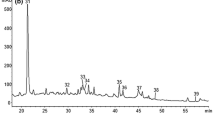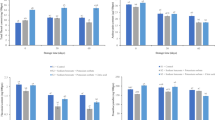Abstract
Takju, popularly known as makgeolli, is a famous traditional alcoholic beverage in Korea. Beneficial health effects of different traditional beverages have received attention among consumers and researchers. The influence of addition of blueberry and black rice powders to takju was investigated. Chemical characteristics, color values, DPPH radical scavenging activities, total phenolic contents, and sensory characteristics were evaluated. Addition of blueberry and black rice powders improved the antioxidant activity and the overall taste of takju. The optimum proportions of added blueberry and black rice powders were 0.249% and 0.004–0.049%, respectively. Addition of optimum amounts of blueberry and black rice powders enhanced the overall quality of the Korean traditional rice wine takju.
Similar content being viewed by others
References
Kim JH, Lee DH, Chio SY, Lee JS. Characterization of physiological functionalities in Korean traditional liquors. Korean J. Food Sci. Technol. 34: 118–122 (2002)
Kim JH, Lee SH, Kim NM, Choi SY, Yoo JY, Lee JS. Manufacture and physiological functionality of Korean traditional liquors by using dandelion (Taraxacum platycarpum). Korean J. Microbiol. Biotechnol. 28: 367–371 (2000)
Lee DH, Kim JH, Kim NM, Lee JS. Manufacture and physiological functionality of Korean traditional liquor by using chamomile (Matricaria chamomile). Korean J. Food Sci. Technol. 34: 109–113 (2002)
Seo SB, Kim JH, Kim NM, Choi SY, Lee JS. Effect of Acasia (Robinia pseudo-acasia) flower on the physiological functionality of Korean traditional rice wine. Korean J. Microbiol. Biotechnol. 30: 410–414 (2002)
Lee DH, Kim JH, Kim NM, Pack JS, Lee JS. Manufacture and physiological functionality of Korean traditional liquors by using Paecilomyces japonica. Korean J. Mycol. 30: 141–146 (2002)
Saito Y, Ohura S, Kawato A, Suginami K. Prolyl endopeptidase inhibitors in sake and its byproducts. J. Agr. Food Chem. 45: 720–724 (1997)
Woo IS, Kim IH, Yun UJ, Chung SK, Rhee IK, Choi SW, Park HD. An improved method for determination of ethyl carbamate in Korean traditional rice wine. J. Ind. Microbiol. Biot. 26: 363–368 (2001)
Lee JS, Lee TS, Noh BS, Park SO. Quality characteristics of mash of takju prepared by different raw materials. Korean J. Food Sci. Technol. 28: 330–336 (1996)
Park CS, Lee TS. Quality characteristics of takju prepared by wheat flour nuruks. Korean J. Food Sci. Technol. 34: 296–302 (2002)
Bae SH, Jung EY, Kim SY, Shin KS, Suh HJ. Antioxidant and immuno-modulating activities of Korean traditional rice wine, takju. J. Food Biochem. 34: 233–248 (2010)
Rong XG, Fa BT. Grandiose survey of Chinese alcoholic drinks and beverages. Available from: http://www.sytu.edu.cn/zhgjiu/umain.htm. Accessed Aug. 30, 2014.
Lento S, Pirttijarvi T, Hasu M. Effect of raw materials (currants and apples) on the processability and quality of Finnish country fruit wines. Available from: http://portal.hamk.fi/portal/page/portal/HAMKJulkisetDokumentit/Yleisopalvelut/Julkaisupalvelut/Kirjat/luonto_ja_maaseutu/Effect%20of%20Raw%20Materials%20on%20the%20Processability.pdf. Accessed Aug. 30, 2014.
Smith MAL, Marley KA, Seigler DA, Singletary KW, Meline B. Bioactive properties of wild blueberry fruits. J. Food Sci. 65: 352–356 (2000)
Ough CS, Amerine MA. Methods for Analysis of Musts and Wines. 2nd ed. John Wiley and Sons, New York, NY, USA. pp. 80–107 (1988)
National Rural Resources Development Institute. Food composition table. Rural Development Administration, Seoul, Korea. pp. 353–370 (2006)
Kim ID, Lee JW, Kim SJ, Cho JW, Dhungana SK, Lim YS, Shin DH. Exogenous application of natural extracts of persimmon (Diospyros kaki Thunb.) can help in maintaining nutritional and mineral composition of dried persimmon. Afr. J. Biotechnol. 13: 2231–2239 (2013)
Singleton V, Orthofer R, Lamuela-Raventos R. Analysis of total phenols and other oxidation substrates and antioxidants by means of Folin-Ciocalteu reagent. Vol. 299, pp 152–178. In: Oxidants and Antioxidants. Packer L (ed). Academic Press, New York, NY, USA (1999)
Cheung LM, Cheung PCK, Ooi VEC. Antioxidant activity and total polyphenolics of edible mushroom extracts. Food Chem. 81: 249–255 (2003)
Saftner R, Polashock J, Ehlenfeldt M, Vinyard B. Instrumental and sensory quality characteristics of blueberry fruit from twelve cultivars. Postharvest Biol. Tec. 49: 19–26 (2008)
Abdel-Aal ESM, Young JC, Rabalski I. Anthocyanin composition in black, blue, pink, purple, and red cereal grains. J. Agr. Food Chem. 54: 4696–4704 (2006)
Ichikawa H, Ichiyanagi T, Xu B, Yoshii Y, Nakajima M, Konishi T. Antioxidant activity of anthocyanin extract from purple black rice. J. Med. Food 4: 211–218 (2001)
Bunea A, Ruginã OD, Pintea AM, Sconþa Z, Bunea CI, Socaciu C. Comparative polyphenolic content and antioxidant activities of some wild and cultivated blueberries from Romania. Not. Bot. Horti Agrobo. 39: 70–76 (2011)
Huang WY, Zhang HC, Liu WX, Li CY. Survey of antioxidant capacity and phenolic composition of blueberry, blackberry, and strawberry in Nanjing. J. Zhejiang Univ. Sc. B 13: 94–102 (2012)
Giovanelli G, Buratti S. Comparison of polyphenolic composition and antioxidant activity of wild Italian blueberries and some cultivated varieties. Food Chem. 112: 903–908 (2009)
Johnson MH, Lucius A, Meyer T, de Mejia EG. Cultivar evaluation and effect of fermentation on antioxidant capacity and in vitro inhibition of α-amylase and α-glucosidase by highbush blueberry (Vaccinium corombosum). J. Agr. Food Chem. 59: 8923–8930 (2011)
Muntana N, Prasong S. Study on total phenolic contents and their antioxidant activities of Thai white, red and black rice bran extracts. Pakistan J. Biol. Sci. 13: 170–174 (2010)
Hong YH, Bae SH, Jung EY, Son HS, Shin KS, Kwon KH, Suh HJ. Radical scavenging activities of Korean traditional rice wine, takju. Food Ind. Nutr. 14: 109–115 (2009)
Author information
Authors and Affiliations
Corresponding author
Rights and permissions
About this article
Cite this article
Kim, MO., Kim, ID., Dhungana, S.K. et al. Influence of blueberry and black rice powders on quality characteristics of the Korean traditional rice wine takju . Food Sci Biotechnol 24, 439–444 (2015). https://doi.org/10.1007/s10068-015-0058-3
Received:
Revised:
Accepted:
Published:
Issue Date:
DOI: https://doi.org/10.1007/s10068-015-0058-3




